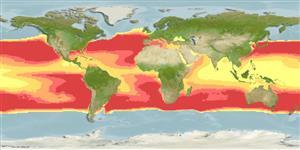Classificação / Names
Common names from other countries
Referência principal
Tamanho / Peso / Idade
Max length : 140 cm FL macho/indeterminado; (Ref. 3669); common length : 100.0 cm FL macho/indeterminado; (Ref. 9684); Peso máx. publicado: 60.3 kg (Ref. 40637); Idade máx. registada: 9 anos (Ref. 72462)
Length at first maturity
Lm 85.0, range 85 - ? cm
Ambiente
; marinhas; oceanódromo (Ref. 51243); intervalo de profundidade 0 - 600 m (Ref. 168)
Clima / Intervalo
Subtropical; 10°C - 25°C (Ref. 168), preferred 27°C (Ref. 107945); 59°N - 46°S, 180°W - 180°E
Distribuição
Cosmopolitan in tropical and temperate waters of all oceans including the Mediterranean Sea but not at the surface between 10°N and 10°S. Western Pacific: range extend in a broad band between 40°N and 40°S (Ref. 9684). Often confused with juvenile Thunnus obesus which also have very long pectorals but with rounded tips. Highly migratory species, Annex I of the 1982 Convention on the Law of the Sea (Ref. 26139).
Países | Áreas FAO | Ecossistemas | Ocorrências | Introduções
Descrição breve
Espinhos dorsais (total): 11 - 14; Raios dorsais moles (total): 12-16; Espinhos anais 0; Raios anais moles: 11 - 16. Anterior spines much higher than posterior spines giving the fin a strongly concave outline. Interpelvic process small and bifid. Body with very small scales. Pectoral fins remarkably long, about 30% of fork length or longer in 50 cm or longer fish. Ventral surface of liver striated and the central lobe is largest.
Categoria na Lista Vermelha da IUCN (Ref. 115185)
Ameaça para o homem
Harmless
Utilização humana
Pescarias: altamente comercial; peixe desportivo: sim
Ferramentas
Relatórios especiais
Descarregue XML
Fontes da internet
Estimates of some properties based on models
Phylogenetic diversity index
PD50 = 0.5039 many relatives (e.g. carps) 0.5 - 2.0 few relatives (e.g. lungfishes)
Nível Trófico
4.3 ±0.2 se; Based on diet studies.
Resiliência
Médio, tempo mínimo de duplicação da população 1,4 - 4,4 anos (K=0.13-0.18; tm=4-6; tmax=10; Fec=2 million)
Vulnerabilidade
High vulnerability (58 of 100)
Categoria de preço
